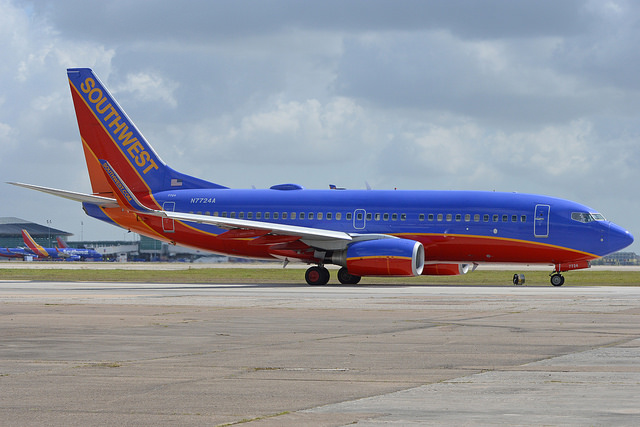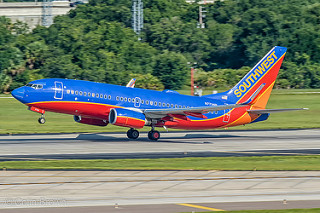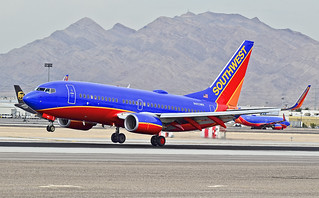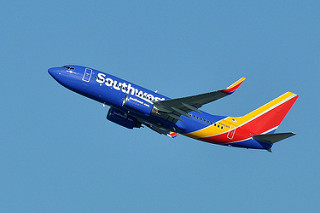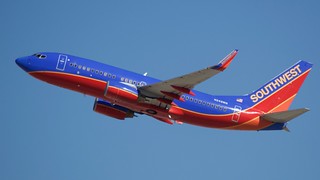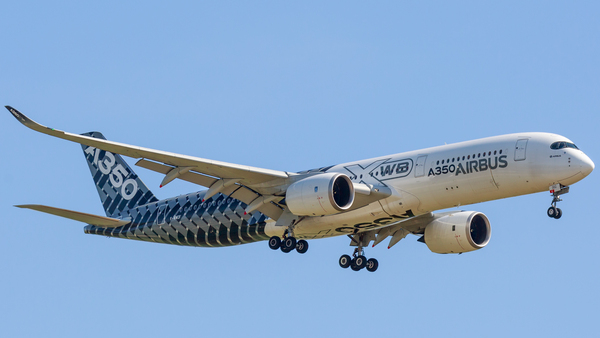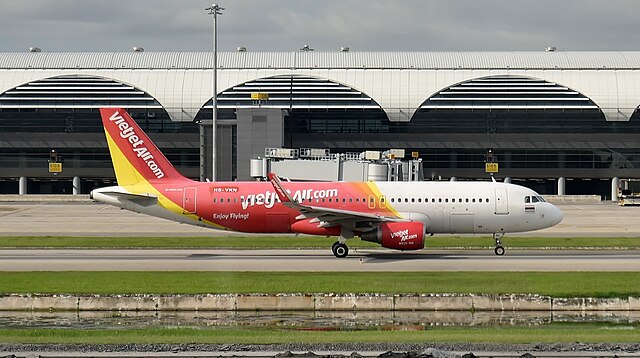Southwest B737 at Houston on Apr 17th 2025, engine shut down in flight
Last Update: October 24, 2025 / 09:51:31 GMT/Zulu time
Incident Facts
Date of incident
Apr 17, 2025
Classification
Accident
Airline
Southwest Airlines
Flight number
WN-3006
Departure
Houston Hobby, United States
Destination
San Jose Cabo, Mexico
Aircraft Registration
N7724A
Aircraft Type
Boeing 737-700
ICAO Type Designator
B737
Emergency services reported they needed to extinguish an engine fire as well as a small grass fire near the runway.
The FAA reported: "Southwest Airlines Flight 3006 returned safely to William P. Hobby Airport in Houston around 11:45 a.m. local time on Thursday, April 17, after the crew reported an engine issue. Passengers exited the aircraft on a taxiway. The Boeing 737 was headed to Los Cabos International Airport in Mexico. The FAA will investigate."
A replacement Boeing 737-700 registration N447WN reached San Jose Cabo with a delay of about 3:45 hours.
On Oct 24th 2025 the NTSB released their final report and investigation docket concluding the probable cause of the accident was:
Serious Injury to a flight attendant sustained during an evacuation.
The NTSB analysed:
According to the flight crew, they were on day two, leg two, of a three-day line experience rotation. The first officer (FO), pilot flying, was returning from leave and the captain (CA) was a line check airman for the company. During the preflight, the flight crew discussed the automatic terminal information service (ATIS) reporting windshear and planned for a precautionary takeoff profile. The flight crew briefed the engine out procedures and the takeoff profile for runway 22. The taxi and takeoff were normal.
During climb out, the flight crew observed the right engine exhaust gas temperature (EGT) indication momentarily increase into the red overtemp range, then decrease. The flight crew then heard a “popping” noise and observed the right engine N1 indication decrease to approximately 50%. The CA declared an emergency with air traffic control (ATC) and initiated the Engine Fire, Severe Damage or Separation quick reference checklist (QRC) and the quick reference handbook (QRH) procedures. The FO continued as the pilot flying and coordinated vectors for a return to HOU.
The “A” FA contacted the cockpit to inform them of a burning odor in the cabin. The CA informed the FAs that they had an engine malfunction and were returning to HOU. The CA then made a public announcement informing the passengers that they would be landing in 20 minutes.
After completing all appropriate checklists, the CA assumed control of the aircraft, and the FO transitioned to the pilot monitoring. The approach and landing were uneventful. ATC requested that the flight crew exit the runway at the end and coordinate with airport rescue firefighting (ARFF). After clearing the runway and stopping, the CA contacted the FA’s and was informed that there was still a strong burning odor in the cabin. At that time, the CA elected to initiate an evacuation of the airplane. The CA informed ARFF of the decision and the FO began the QRH for an evacuation. The flight crew completed the QRH procedure, including left engine shutdown and FLAP 40 extension, and the CA commanded an evacuation via the left side of the aircraft.
The FO evacuated the aircraft to assist with the evacuation while the CA remained onboard until all passengers had evacuated. The CA observed passengers re-entering the aircraft from the overwing exits and then utilizing the door slides. After all passengers and flight attendants had evacuated the aircraft, the CA conducted a final walkthrough and evacuated the aircraft.
On the ground, the CA learned that ARFF personnel had directed passengers back into the aircraft due to concerns of injuries sliding off the wing.
According to the “B” FA, seated in the aft galley, during takeoff there was a loud noise and followed by a burning odor. As the aircraft continued to climb the odor intensity decreased and they inspected the area and were unable to identify a source. The B FA contacted the A FA and informed them of the odor. The CA made an announcement that they had experienced an engine failure, and they would be landing in approximately 20 minutes. After landing and stopping, the CA called the FAs and asked if the odor still existed, to which the B FA replied that they still smelled a burning odor.
After the evacuation, the B FA reported an injury to their ankle. They were diagnosed with a hairline fracture.
Aircraft Registration Data
Incident Facts
Date of incident
Apr 17, 2025
Classification
Accident
Airline
Southwest Airlines
Flight number
WN-3006
Departure
Houston Hobby, United States
Destination
San Jose Cabo, Mexico
Aircraft Registration
N7724A
Aircraft Type
Boeing 737-700
ICAO Type Designator
B737
This article is published under license from Avherald.com. © of text by Avherald.com.
Article source
You can read 2 more free articles without a subscription.
Subscribe now and continue reading without any limits!
Read unlimited articles and receive our daily update briefing. Gain better insights into what is happening in commercial aviation safety.
Send tip
Support AeroInside by sending a small tip amount.
Related articles
Southwest B737 near Houston on Feb 18th 2018, loss of cabin pressure
A Southwest Airlines Boeing 737-700, registration N7724A performing flight WN-289 from Belize (Belize) to Denver,CO (USA), was enroute at FL380 over…
Southwest B738 at Orlando on Mar 20th 2025, attempted to takeoff from taxiway
A Southwest Airlines Boeing 737-800, registration N8315C performing flight WN-3278 from Orlando,FL to Albany,NY (USA), was cleared for takeoff from…
Southwest B737 at San Diego on Aug 11th 2023, cleared to line up then forgotten, overflown by Citation on short final
A Southwest Airlines Boeing 737-700, registration N7734H performing flight WN-2493 from San Diego,CA to San Jose,CA (USA), was at holding point B1…
Southwest B737 at Burbank on Sep 11th 2025, engine failure
A Southwest Boeing 737-700, registration N465WN performing flight WN-1394 from Burbank,CA to Phoenix Sky Harbour,AZ (USA), was climbing out of…
Southwest B737 at Columbus on Aug 13th 2025, flaps up landing
A Southwest Airlines Boeing 737-700, registration N565WN performing flight WN-2150 from Houston Hobby,TX to Columbus,OH (USA) with 116 people on…
Southwest B737 and Military HUNT near Burbank on Jul 25th 2025, TCAS saves the day
A Southwest Airlines Boeing 737-700, registration N249WN performing flight WN-1496 from Burbank,CA to Las Vegas,NV (USA), was climbing through about…
Newest articles
Thai A359 enroute on Aug 20th 2025, turbulence causes 5 injuries
A Thai Airways Airbus A350-900, registration HS-THY performing flight TG-925 from Munich (Germany) to Bangkok (Thailand), was enroute over Thailand…
Thai Viet A320 at Chiang Mai on Oct 16th 2025, cargo smoke indication
A Thai Vietjetair Airbus A320-200, registration HS-VKN performing flight VZ-106 from Bangkok to Chiang Mai (Thailand), was descending towards Chiang…
Subscribe today
Are you researching aviation incidents? Get access to AeroInside Insights, unlimited read access and receive the daily newsletter.
Pick your plan and subscribePartner

ELITE Simulation Solutions is a leading global provider of Flight Simulation Training Devices, IFR training software as well as flight controls and related services. Find out more.
SafetyScan Pro provides streamlined access to thousands of aviation accident reports. Tailored for your safety management efforts. Book your demo today
AeroInside Blog
Popular aircraft
Airbus A320Boeing 737-800
Boeing 737-800 MAX
Popular airlines
American AirlinesUnited
Delta
Air Canada
Lufthansa
British Airways

